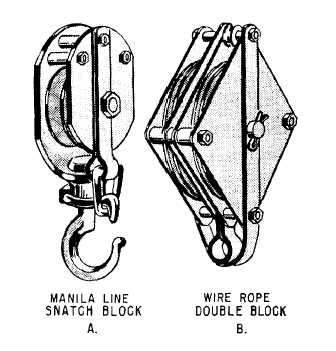block remains stationary. The term "two-blocked" means that both blocks of a tackle are as close together as they will go. You may also hear this term called block-and-block. To overhaul is to lengthen a tackle by pulling the two blocks apart. To round in means to bring the blocks of a tackle toward each other, usually without a load on the tackle (opposite of overhaul).
Don't be surprised if your coworkers use a number of different terms for a tackle. For example, line-and-blocks, purchase, and block-and-falls are typical of other names frequently used for tackle.
BLOCK NOMENCLATURE
The block (or blocks) in a tackle assembly changes (or change) the direction of pull or mechanical advantage, or both. The name and location of the key parts of a fiber line block are shown in figure 4-18.
The frame (or shell), made of wood or metal, houses the sheaves. The sheave is a round, grooved wheel over which the line runs. Ordinarily, blocks used in your work will have one, two, three, or four sheaves. Blocks come with more than this number of sheaves; some come with 11 sheaves. The cheeks are the solid sides of the frame, or shell. The pin is a metal axle that the sheave turns on. It runs from cheek to cheek through the middle of the sheave. The becket is a metal loop formed at one or both ends of a block; the standing part of the line is fastened to this part. The straps hold the block together and support the pin on which the sheaves rotate. The swallow is the opening in the block through which the line passes. The breech is the part of the block opposite the swallow.
CONSTRUCTION OF BLOCKS
Blocks are constructed for use with fiber line or wire row. Wire rope blocks are heavily constructed and have a large sheave with a deep groove. Fiber line blocks are generally not as heavily constructed as wire rope blocks and have smaller sheaves with shallower wide grooves. A large sheave is needed with wire rope to prevent sharp bending. Since fiber line is more flexible and pliable than wire rope, it does not require a sheave as large as the same size of wire rope.
Blocks fitted with one, two, three, or four sheaves are often referred to as single, double, triple, and quadruple blocks, respectively. Blocks are fitted with a number of attachments, the number depending upon their use. Some of the most commonly used fittings are hooks, shackles, eyes, and rings. Figure 4-21 shows two metal frame, heavy-duty blocks. Block A is designed for manila line, and block B is for wire rope.
RATIO OF BLOCK SIZE TO LINE OR WIRE SIZE
The size of fiber line blocks is designated by the length in inches of the shell or cheek. The size of standard wire rope blocks is controlled by the diameter of the rope. With nonstandard and special-purpose wire rope blocks, the size is found by measuring the diameter of one of its sheaves in inches.
Use care in selecting the proper size line or wire for the block to be used. If a fiber line is reeved onto a tackle whose sheaves are below a certain minimum diameter, the line will be distorted and will soon wear badly. A wire rope too large for a sheave tends to be pinched and damages the sheave. The wire will also be damaged due to the too short a radius of the bend. A wire rope too small for a sheave lacks the necessary bearing surface, puts the strain on only a few strands, and shortens the life of the wire.
With fiber line, the length of the block used should be about three times the circumference of the

Figure 4-21. - Metal frame, heavy-duty blocks.
Continue Reading